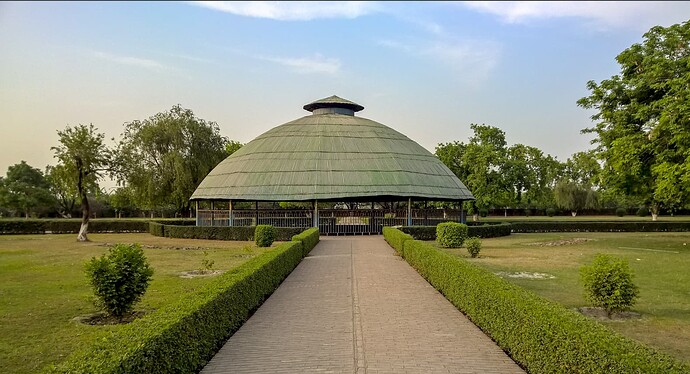The Indian state of Bihar boasts Vaishali, a city with significant cultural and historical importance. King Vishal lent his name to this capital city, which once served as the seat of power for the Licchavi republic among the world’s first republics during the Mahabharata era. As a bustling trade hub, Vaishali’s prosperity painted an impressive picture through its architectural grandeur and rich cultural tapestry. Lord Buddha made three visits to Vaishali, where he stayed for several months. During his time there, he preached and performed miracles; furthermore, he delivered the Ratana Sutta a discourse emphasizing the virtues of Buddhism’s Three Jewels: The Buddha himself was one jewel the embodiment of enlightenment, followed by Dharma the universal truth discovered and taught by him–and finally Sangha the community that supports spiritual progress. As Lord Buddha neared his final days on earth announcing his impending parinirvana or ultimate nirvana he chose Vaishali as the location for giving what would be remembered as His last sermon.
The Second Buddhist Council, a significant event in the history of Buddhism, also took place in this city. Several stupas and relics associated with Buddha inhabit the city; therefore, it holds revered status among Buddhists globally.
Equally significant in the history of Jainism, Vaishali believed to be Lord Mahavira’s birthplace and founder of the religion herself; boasts a plethora of Jain temples. More than just an ancient city: it holds worldwide reverence as a sacred site for Jains. For those with an interest in delving into India’s rich cultural heritage, a visit to Vaishali is imperative: it served as the birthplace of Lord Mahavira the 24th Tirthankara within Jainism in 599 BC. Devotees from across the globe are drawn to this city which boasts several ancient Jain temples.
The Abhisek Pushkarini, also known as the coronation tank, stands among Vaishali’s most sacred attractions. Water from this reservoir once anointed elected representatives of the Vajji Republic an eight clan federation led by prominent Licchavis and Videhas. A vibrant garden envelops the tank while a museum adjacent showcases numerous artefacts dating back to antiquity.
Vaishali also identified as Vesali or Vaiśālī: a city of remarkable historical importance situated in contemporary Bihar, India now stands as an archaeological site; it forms an integral part of the Tirhut Division.
During the 6th century BCE, Vaishali acted as the capital for Vajjika League of Vrijji mahajanapada an early republic that thrived. This city served not only as a bustling trade hub but also drew scholars and traders from distant regions due to its rich cultural scene.
In 249 BC, the devout Buddhist Mauryan Emperor Ashoka visited Vaishali; he erected one of his renowned lion pillars here a symbol that still stands today to represent this city’s historical importance. The Ashoka Pillar, capped by a solitary Asiatic lion, remains remarkably well preserved among all the Pillars of Ashoka.
The Mauryan Empire’s decline ushered Vaishali into a phase of political instability; withinnevertheless, it steadfastly maintained its significance as a trade and culture hub. The Gupta period (4th to 6th century AD) marked an upswing in art and culture within Vaishali. The city was adorned with beautiful buildings and became a center for learning.
Possibly housing the earliest known stupa, Vaishali is home to the Buddha relic. The ashes of Gautama Buddha, who delivered his final sermon in this city before dying around 483 BCE, are believed to reside within that very stupa. King Kalasoka convened the Second Buddhist Council here in 383 BCE, thereby cementing Vaishali’s significance for both Jainism and Buddhism.
British archaeologists rediscovered Vaishali, a city whose importance had gradually waned over time until it was eventually abandoned. Through their excavations in the 19th century, they illuminated its glorious past by bringing to light its ruins. Travel accounts of Chinese explorers Faxian and Xuanzang mention this city. In 1861, British archaeologist Alexander Cunningham utilized these accounts to initially correlate Vaiśālī with its contemporary site: Basarh situated in the Vaishali District of Bihar.
Historians, archaeologists, and tourists all find themselves drawn to Vaishali in the present day. Its rich past manifests visibly through its ancient ruins, stupas, and pillars. Moreover; as an important pilgrimage site for Buddhists as well as Jains – this city holds significant historical significance.
Vaishali’s history narrates a captivating saga of ascent, splendor, downfall, and revival; it provides an unparalleled peek into the vast cultural heritage of India. This narrative remains not only inspiring to historians but also captivates culture enthusiasts: indeed—a potent testament—this city’s tale showcases both the resilience and everlasting fascination inherent in ancient civilizations.
King Vishal’s story the eponym of this city: it intertwines with the metropolis’ early history. A thriving hub of trade and commerce, the city boasted prosperity; such wealth we find well documented in ancient texts.
Vaishali’s significance diminished over time, eventually leading to its abandonment. British archaeologists did not rediscover the city and commence excavations of its ruins until the 19th century. Even today, historians and tourists alike are drawn to explore Vaishali’s ancient city due to their eagerness to delve into its wealthy past.
